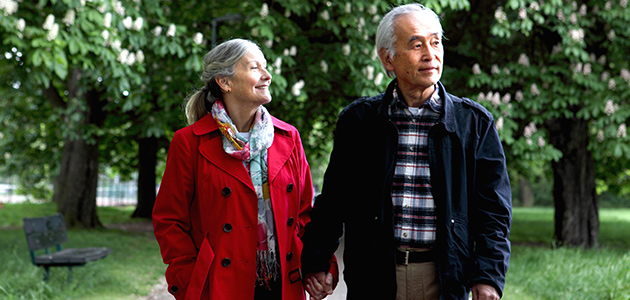
Regular exercise is an important factor in healthy aging. Research shows that being active can boost self-esteem, mood, sleep quality and energy, as well as reduce your risk of stress, depression, dementia, and Alzheimer’s disease. Those are very compelling reasons to lace up your shoes and get outside for a walk!
While any exercise you can get is beneficial, according to McMaster University, improving your walking speed is associated with improvements in 8-year survival.2 It also improves body strength, cardiovascular fitness, and the strength and flexibility of your muscles and nerves.3
Aging does change the way we walk. We may be slower, less steady, a little less coordinated, and our posture may not be as upright as it once was. But these changes don’t have to stop us from getting out and hitting the pavement.
McMaster Optimal Aging Portal4 has some practical suggestions for increasing walking speed and strengthening our bodies in the process. If you are confident that you can safely do these exercises and have checked with your doctor, consider trying these:
- Improve the body structures necessary for walking. These
exercises can help target the parts of your body that are used to walk:- Strengthening leg muscles:
- Sit in a chair, and then stand up. Repeat
- Stand close to something that can support you if you lose your balance,
and then practice rising up on your toes, and then back onto your heels. - Stand on the edge of a step with your forefoot supported. Support
yourself with your arms, and then depress your heel.
- Stretching:
- Lie on your left side. Raise your right leg and move it backwards as
far as you can. Hold, and then return it to the resting position. Repeat
on the other side.
- Lie on your left side. Raise your right leg and move it backwards as
- General fitness:
- Cycle on a stationary bike.
- March on the spot.
- Strengthening leg muscles:
- Train your brain to walk more efficiently. These training
exercises can help improve your walking skill and make it easier to adapt to
changes in your environment as you walk by deliberately engaging your brain:- Practice walking. Be aware of your walking. Consciously
monitor your progress and try to increase your speed over short distances.
Practice changing directions, walking sideways, forwards and backwards.
Practice walking while you are carrying objects, and walk while counting
or listening to music to make your walking consistently rhythmical. - Practice stepping over objects as you walk. Place several
objects on the floor of a room. Walk over to the objects, step over them
and continue walking. Take note of how your body changes and adjusts as
it steps over the objects.
- Practice walking. Be aware of your walking. Consciously
It may seem strange to have to practice how to walk – we learned how to do it quite some time ago, after all! But as the body changes, we have to make certain adjustments in order to keep it moving. It’s well worth the effort if it means you can increase your walking speed and potentially increase the length of your life.
SOURCES
1 http://www.nhs.uk/Livewell/fitness/Pages/Whybeactive.aspx
416163E CAN/US (05/18)




